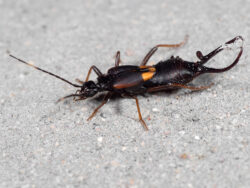Earwigs are a common household pest in Florida. These nocturnal insects resemble beetles, growing 1/4″ to 1″ in length. They have reddish brown bodies with translucent yellow wings and legs. They also have pincer-like appendages. While earwigs aren’t harmful to humans, they can cause damage to crops and contaminate produce. Besides what they look like, what else should you know about earwigs? Here’s the 411 on these common pests.
- They love moisture and humidity. Earwigs prefer wet, moist surroundings. They are drawn to topsoil because it allows them to keep cool and protected in a dark and damp environment. They will be drawn to your home if it provides an appealing environment. Earwig infestations are frequent in low, humid parts of your home, such as your basement. You may have brought them inside, or they may have crept in through openings along the baseboards or window wells.
- They will hitchhike indoors. Darkness, humidity, moisture, and shelter all attract earwigs. They enjoy digging in (sometimes literally) when they find appropriate places. Because of these qualities, they are extremely mobile, unintentional hitchhikers. They, like bed bugs, frequently find their way into various bags or crates. When you carry such bags or cartons inside, you unintentionally bring in earwigs. Earwigs are particularly prone to infesting bags of dirt, fertilizer, or seeds.
- They do, in fact, have wings. Earwigs don’t fly well, although they do have useful wings. These wings may be used to jump short distances, break falls, or escape danger. Unfolded earwig wings resemble human ears, which some believe is where the name comes from.
- They aren’t picky eaters. Earwigs are omnivorous foragers, which means they don’t discriminate. Though they love rotting vegetation, they will consume almost everything. Earwigs frequently hunt and eat lesser insect pests. They catch and hold their prey with their forceps before consuming them. Earwigs will consume anything they can find in and around your home. Earwigs are drawn to decomposing plant debris because it provides a humid, moist food source on which they can rely. Earwigs may burrow under or near decomposing plant material to conceal and feed in some instances. They will also consume healthy plant material, especially if it is nearby.
- They’re invasive. Earwigs are not native to the United States, but they have been present since at least 1907. The European Earwig, the most common earwig in North America, is found throughout the country.
- They like to hide. Earwigs are most commonly found under thin layers of topsoil in your garden or yard. They enjoy burrowing through earth in order to remain hidden, wet, and cool. They also consume subterranean plant life and excavate little nests for their eggs. While digging in your garden, you may come across earwigs on a regular basis.
- They are not harmful to humans. Earwigs are not hazardous, but if they feel frightened or disturbed, they will use their pincers on people. If you try to pick up or handle an earwig, it will usually pinch you. These pincers are unlikely to break your skin, although the pinching may be uncomfortable. It may also cause a tiny bruise or welt. You should not pick up earwigs with your bare hands. Earwigs are not aggressive and only lash out in self-defense or in times of fear. They can’t significantly damage you even if they pinch you. Earwigs do not spread diseases, and cannot cause substantial structural damage. They may be inconvenient, but they are not harmful.
- They don’t crawl in ears. This is a frequent misconception concerning earwigs. Despite their name, they do not creep inside and infest people’s ears. They don’t go through the ear and lay eggs in the brain, as some of the more fantastical stories claim. They prefer dark, warm, and humid environments, therefore they could be drawn to a sleeping person’s ear. This is a highly unusual occurrence, because the bug would not stay long, lay eggs, or burrow. You shouldn’t be concerned about earwigs getting inside your ears.
If you have a problem with earwigs, you can get rid of them by:
- Spraying leaves with a soap-and-water mixture or a mixture of equal parts 70% rubbing alcohol and water–spray only one leaf at a time and check back in 24 hours to ensure it won’t harm the plant.
- Making an earwig trap by dampening a cardboard tube or rolled-up newspaper.
- Adding beneficial predators such as birds and toads to your backyard or garden.
- Caulking gaps and cracks around your foundation, doors, and vents to keep your home sealed.
- Trimming trees away from your house’s exterior.
- Removing deteriorated plant materials such as dead leaves, fruit, and branches.
- Avoiding squishing them since they will emit a foul-smelling liquid.
If you have an earwig infestation or just want some assistance in keeping them out, contact your local pest control company for an inspection.



